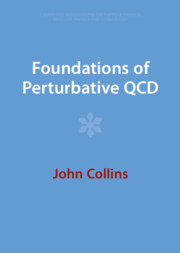
-
Select format
-
- Publisher:
- Cambridge University Press
- Publication date:
- 13 July 2023
- 27 July 2023
- ISBN:
- 9781009401845
- 9781009401838
- 9781009401821
- Creative Commons:
-
This content is Open Access and distributed under the terms of the Creative Commons Attribution licence CC-BY-NC-ND 4.0.
https://creativecommons.org/creativelicenses - Dimensions:
- (244 x 170 mm)
- Weight & Pages:
- 1.246kg, 638 Pages
- Dimensions:
- (244 x 170 mm)
- Weight & Pages:
- 1.11kg, 638 Pages
Open AccessYou have digital access to this book
Book description
The most non-trivial of the established microscopic theories of physics is quantum chromodynamics, QCD, the theory of the strong interaction. A critical link between theory and experiment is provided by the methods of perturbative QCD, notably the well-known factorization theorems. Giving an accurate account of the concepts, theorems and their justification, this book is a systematic treatment of perturbative QCD. As well as giving a mathematical treatment, the book relates the concepts to experimental data, giving strong motivations for the methods. It also examines in detail transverse-momentum-dependent parton densities, an increasingly important subject not normally treated in other books. Ideal for graduate students starting their work in high-energy physics, it will also interest experienced researchers wanting a clear account of the subject. First published in 2011, this title has been reissued as an Open Access publication on Cambridge Core.
Contents
Full book PDF-
Frontmatter
pp i-iv -
-
- You have access
- Open access
- Export citation
-
-
Contents
pp v-x -
-
- You have access
- Open access
- Export citation
-
-
Dedication
pp xi-xi -
-
- You have access
- Open access
- Export citation
-
-
Acknowledgments
pp xii-xii -
-
- You have access
- Open access
- Export citation
-
-
1 - Introduction
pp 1-7 -
-
- You have access
- Open access
- Export citation
-
-
2 - Why QCD?
pp 8-35 -
-
- You have access
- Open access
- Export citation
-
-
3 - Basics of QCD
pp 36-68 -
-
- You have access
- Open access
- Export citation
-
-
4 - Infra-red safety and non-safety
pp 69-86 -
-
- You have access
- Open access
- Export citation
-
-
5 - Libby-Sterman analysis and power-counting
pp 87-160 -
-
- You have access
- Open access
- Export citation
-
-
6 - Parton model to parton theory: simple model theories
pp 161-212 -
-
- You have access
- Open access
- Export citation
-
-
7 - Parton theory: further developments
pp 213-242 -
-
- You have access
- Open access
- Export citation
-
-
8 - Factorization for DIS, mostly in simple field theories
pp 243-283 -
-
- You have access
- Open access
- Export citation
-
-
9 - Corrections to the parton model in QCD
pp 284-312 -
-
- You have access
- Open access
- Export citation
-
-
10 - Factorization and subtractions
pp 313-397 -
-
- You have access
- Open access
- Export citation
-
-
11 - DIS and related processes in QCD
pp 398-425 -
-
- You have access
- Open access
- Export citation
-
-
12 - Fragmentation functions: e+ e- annihilation to hadrons, and SIDIS
pp 426-478 -
-
- You have access
- Open access
- Export citation
-
-
13 - TMD factorization
pp 479-539 -
-
- You have access
- Open access
- Export citation
-
-
14 - Inclusive processes in hadron-hadron collisions
pp 540-572 -
-
- You have access
- Open access
- Export citation
-
-
15 - Introduction to more advanced topics
pp 573-581 -
-
- You have access
- Open access
- Export citation
-
-
Appendix A: - Notations, conventions, standard mathematical results
pp 582-594 -
-
- You have access
- Open access
- Export citation
-
-
Appendix B: - Light-front coordinates, rapidity, etc.
pp 595-599 -
-
- You have access
- Open access
- Export citation
-
-
Appendix C: - Summary of primary results
pp 600-602 -
-
- You have access
- Open access
- Export citation
-
-
References
pp 603-616 -
-
- You have access
- Open access
- Export citation
-
-
Index
pp 617-624 -
-
- You have access
- Open access
- Export citation
-
Metrics
Full text views
Full text views help Loading metrics...
Loading metrics...
* Views captured on Cambridge Core between #date#. This data will be updated every 24 hours.
Usage data cannot currently be displayed.
Accessibility standard: Unknown
Why this information is here
This section outlines the accessibility features of this content - including support for screen readers, full keyboard navigation and high-contrast display options. This may not be relevant for you.
Accessibility Information
Accessibility compliance for the PDF of this book is currently unknown and may be updated in the future.


